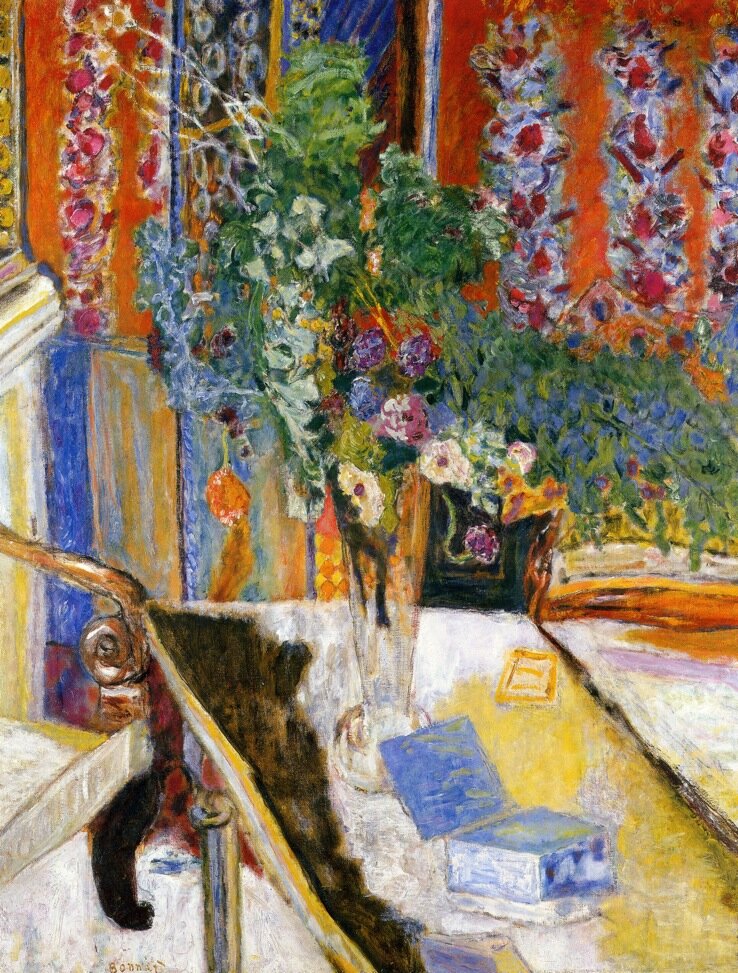Image collection - Kom ihåg Bonnard.
Jag såg Bonnards (1867-1947) ‘Garden’ på the Met i sommras och förälskade mig. De GLÖDANDE färgerna, koncentrationen, tidlösheten, känslorna. Det faktum att alla motiv på tavlorna har samma vikt, buskarna, blommorna, barnen känns så modernt, för att han som Picasso uttrycker det ‘inte kan bestämma sig’ för att ta goda råd och beblandar sig med sitt motiv istället för att ta makten över det. ‘Han målade inte det han såg, men från minnet och skisser.
That’s not painting, what he does. He never looks beyond his own sensibility. He doesn’t know how to choose. When Bonnard paints a sky, perhaps he first paints it blue, more or less the way it looks. Then he looks a little longer and sees some mauve in it, so he adds a touch or two of mauve, just to hedge. Then he decides that maybe it’s a little pink, too, so there’s no reason not to add some pink. The result is a potpourri of indecision. If he looks long enough, he winds up adding a little yellow, instead of making up his mind what color the sky really ought to be. Painting can’t be done that way. Painting isn’t a question of sensibility; it’s a matter of seizing power, taking over from nature, not expecting her to supply you with information and good advice. - Pablo Picasso
Edit 4/12 -19. note to self: Barry Schwabsky, The Nation 2 april 2009 “There is nothing disinterested or neutral about these paintings, which is why the temptation to see Bonnard as a formalist must be resisted even more strongly than the temptation to see the paintings as a diary of the painter’s life–which the paintings never really tell you anything about. There is deep emotion here, but it’s all caught up in the paint, despite not being about the paint. Everything smolders. Color is overheated, even lurid. The deepest shadows seem to have a fire burning within them. The glow of these paintings is that of iron in the forge, each ingot ready to be bent or hammered on the anvil. For all the apparent softness of things, their blurred and smudged edges, they have been fitted together with a will, worked patiently and hard so as to be pressed into the pictorial grid. The paintings are disquieting and enraptured all at once, but they never want to tell you why.” Then he comes with an answer but you will have to read it here.
Another great article on Bonnards painting methods in three parts here
Garden, 1935
Landscape at Le Cannet, y ?, Musée Bonnard, Le Cannet
Young girl playing with a dog, 1913, 75x80 cm
The Pastoral Symphony , 1916-1920, Oil on canvas, 130 × 160 cm, Musee d’Orsay
Interior with flower, 1919, 116.2 x 88.9 cm
‘Busy uncertainty’, 1917, FONDATION MARGUERITE ET AIME MAEGHT, SAINT-PAUL, FRANCE,
Paysage du midi et deux enfants, 1916-1918. Oil on canvas, 139,1 x 198,1 cm. Art Gallery of Ontario, Toronto, don de Sam et Ayala Zacks, 1970
Nude in Bathtub (Grand nu à la Baignoire), 1940-1946,
Nude in the Bath, 1936









